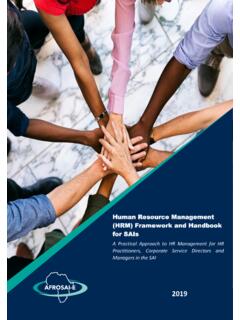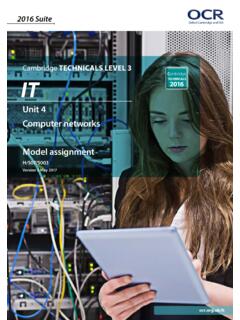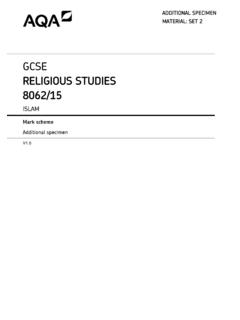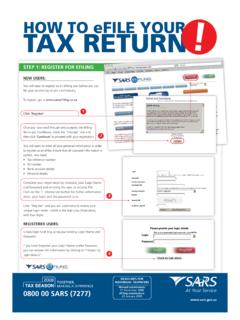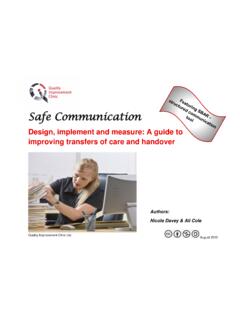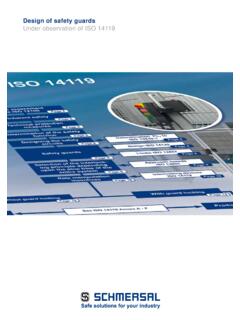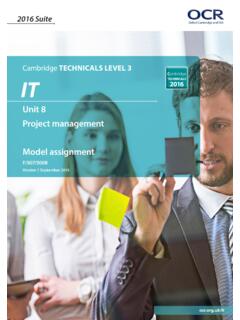Transcription of IT AUDIT MANUAL (ITAM) - AFROSAI-E
1 IT AUDIT MANUAL (ITAM) 1st Edition November 2017 African Organisation of English-Speaking Supreme AUDIT Institutions AFROSAI-E INFORMATION TECHNOLOGY AUDIT GUIDELINE - 2017 Copyright 2017 by AFROSAI-E All rights reserved. This book or any portion thereof may not be reproduced or used in any manner whatsoever without the express written permission of the publisher except for the use of brief quotations in a book review. Printed in South Africa First Printing, 2017 ISBN 978-0-6399943-2-1 AFROSAI-E AFROSAI-E INFORMATION TECHNOLOGY AUDIT GUIDELINE - 2017 TABLE OF CONTENTS TABLE OF CONTENTS .. 1 ABBREVIATIONS .. 3 1. Chapter 1: Introduction To IT Auditing .. 4 2. Chapter 2: Standards and frameworks .. 9 3. Chapter 3: IT risk assessment and risk based auditing .. 14 4. Chapter 4: Understanding IT controls .. 23 5. Chapter 5: Overview of Planning .. 40 6. Chapter 6: IT Governance .. 47 7. Chapter 7: AUDIT of Information System Acquisition, Development and Maintenance.
2 52 8. Chapter 8: IT operations and IT Key performance indicators .. 60 9. Chapter 9: Information security .. 68 10. Chapter 10: Change management .. 73 11. Chapter 11: AUDIT of business continuity and disaster recovery .. 78 12. Chapter 12: IT outsourcing .. 85 13. Chapter 13: AUDIT of ERPs .. 91 14. Chapter 14: Reporting .. 101 15. REFERENCES .. 105 AFROSAI-E INFORMATION TECHNOLOGY AUDIT GUIDELINE - 2017 ABBREVIATIONS CAATs - Computer Assisted AUDIT Techniques CIA - Confidentiality, Integrity and Availability CISA - Certified Information Systems Auditor COBiT- Control Objectives for Information and related Technology COSO - Committee of Sponsoring Organisations ERP - Enterprise Resource Planning ICT - Information and Communication Technologies IS - Information Systems ISACA - Information System AUDIT & Control Association ISO - International Standards Organisation IT - Information Technology ITAF Information Technology Assurance Framework ITIL - Information Technology Infrastructure library KPI - Key performance indicators SAI - Supreme AUDIT Institutions TOGAF - The Open Group Architecture Framework AFROSAI-E INFORMATION TECHNOLOGY AUDIT GUIDELINE - 2017 1.
3 CHAPTER 1: INTRODUCTION TO IT AUDITING Introduction Government entities have increasingly adopted Information and Communication Technologies (ICT) to conduct their functions and to deliver various services. The continuous development of ICTs has made it possible to capture, store, process and deliver information electronically. This transition to electronic processing has necessitated significant changes in the environment in which Supreme AUDIT Institutions (SAIs) carry out their work. There is therefore need for auditors to gain assurance on such computerised systems to derive appropriate AUDIT conclusions. IT systems are also commonly referred to as Information Systems (IS). What is IT Auditing? IT AUDIT is the process of deriving assurance on whether the development, implementation, support and maintenance of information systems meets business goals, safeguards information assets and maintains data integrity. In other words, IT AUDIT is an examination of the implementation of IT systems and IT controls to ensure that the systems meet the organisation s business needs without compromising security, privacy, cost, and other critical business elements.
4 IT AUDIT Objectives The objective of IT Audits is to ensure that the IT resources allow organisational goals to be achieved effectively and use resources efficiently. IT audits may cover IT applications, IT operations, IT governance, ERP Systems, IS Security, acquisition of the business solution, System Development, and Business Continuity all of which are specific areas of IS implementation, or could to look at the value proposition the IS Systems may have fulfilled. Some examples of AUDIT objectives are: Review of the controls of the IT systems to gain assurance about their adequacy and effectiveness. Evaluation of the processes involved in the operations of a given area such as a payroll system, or financial accounting system. Evaluation of the performance of a system and its security, for example, a railway reservation system. Examination of the system development process and the procedures. Mandate for IT Audits The mandate of SAI for IT AUDIT shall be derived from the overall mandate provided to the SAI to conduct audits.
5 Some SAIs may also have specific mandate for conducting IT Audits or AUDIT of Information Systems. For many SAIs, the mandate to conduct Financial Audits, Performance Audits, and Compliance audits will be a sufficient mandate to conduct IT Audits. This is because the IT systems support the core AFROSAI-E INFORMATION TECHNOLOGY AUDIT GUIDELINE - 2017 operations of an entity which may include financial systems. Thus, IT Audits may not need any additional mandate. The specific mandate, if provided, should address jurisdiction of AUDIT for auditing IT Systems, which are utilised by the entity to fulfil its functional objectives. It should also provide for timely, unfettered, direct and free access to all necessary documents and information from the entity, both MANUAL and electronic, whether the function or any of its part is insourced or outsourced. Types and Scope of IT Audits IT audits may be carried out as a separate review of information systems or in conjunction with a financial statements AUDIT , a review of internal controls, and/or as Performance Audits of IT Systems or IT Applications.
6 The scope of IT audits also supports Specialised, forensic and Information Systems (IS) development projects Audits. Outlined below is what each AUDIT would entail: IS AUDIT The process collects and evaluates evidence to determine whether the information systems and related resources adequately safeguard assets, maintain data and system integrity and availability, provide relevant and reliable information, achieve organisational goals effectively, consume resources efficiently and have, in effect, internal controls that provide reasonable assurance that business, operational and control objectives will be me and that undesired events will be prevented, or detected and corrected in a timely manner. Financial AUDIT Financial AUDIT seeks to assess the correctness of an organisation s financial statements. IT AUDIT comes in the financial AUDIT to evaluate whether the information systems and related resources (including information) adequately safeguard data integrity.
7 Compliance Audits Compliance AUDIT include specific tests of controls to check for adherence to specific regulations and standards. These audits often overlap traditional IT Audits but may focus on particular systems or data. Performance auditing This is an independent, objective, and reliable examination of whether government undertakings, systems, operations, programmes, activities or entities are operating in accordance with the principles of economy, efficiency, and effectiveness and whether there is room for improvement. IT Auditors shall examine the IT systems implemented with respect to the criteria of economy, efficiency, and effectiveness and value to the citizen. (ISSAI 5300) IT Audits can cover other specialised reviews that examine specific areas, such as outsourcing, or have specific objectives such as digital forensics. AFROSAI-E INFORMATION TECHNOLOGY AUDIT GUIDELINE - 2017 Irrespective of the type of AUDIT , the IT auditor would be required to assess the policies and procedures that guide the overall IT environment of the audited entity, ensuring that the corresponding controls and enforcement mechanisms are in place.
8 From the set objectives of the IT AUDIT , the IT Auditor should decide on the scope of AUDIT . The scoping of the IT AUDIT would involve deciding the extent of AUDIT scrutiny, the coverage of IT systems and their functionalities, IT processes to be audited, locations of IT systems to be covered, and the period to be covered. It will be, essentially, setting or delineating the boundaries of the AUDIT . Overview of the IT AUDIT process IT auditing follows the same stages with a Regularity AUDIT . However, the method and tools used for gathering AUDIT evidence may vary. These stages can be broadly classified as follows: Pre-engagement activities which includes an assessment of the objectivity, integrity and technical capacity of AUDIT staff and establishing the budgeted time for the AUDIT . It also includes gaining a common understanding and expectations through issuing an engagement letter. Understanding the entity Risk Assessment - during which auditors gains understanding of the auditee s environment, identifies and evaluate risks and materiality on an institutional level.
9 This process will also establish and ensure that the auditor has considered all relevant factors surrounding the environment within which the client operates. The overall strategic plan is at this point discussed with the auditee. Performing the AUDIT - here the auditor is expected to understand the detailed processes for each AUDIT component, design AUDIT programs, and document the performance of the programs by completing the templates provided. AUDIT reporting the final management letter that arise from the AUDIT process . At the end of each part the related working papers can be found. A Risk based AUDIT approach should be used when conducting an IT AUDIT . This involves identification of the risk elements in the entity being assessed along with weighted risk scores based on specific evaluation criteria and thus identifying priority area to be audited. This weighted risk score may involve the auditor identifying the impact and likelihood of an adverse effect.
10 Risks may be categorised high, medium and low with the auditor assigning an appropriate measure. ISSAI 5300 requires the auditor to prepare AUDIT documentation that is sufficiently complete and detailed to provide an overall understanding of an AUDIT . The review of the documentation should enable any other IT auditor to reach the same AUDIT conclusions. There is no standard format for IT AUDIT documentation in ISSAIs. Further, the formats may differ from SAI to SAI. There may be certain level of standardisation within each SAI in terms of checklists, specimen letters, organisation of working papers, etc. Throughout the AUDIT process , quality control should be maintained to ensure that AUDIT objectives are met. AFROSAI-E INFORMATION TECHNOLOGY AUDIT GUIDELINE - 2017 Linkages between Financial Auditing and IT Auditing ISSAI 1315 specifies the auditor s responsibility to identify and assess the risks of material misstatement, through understanding of the entity and its environment.
